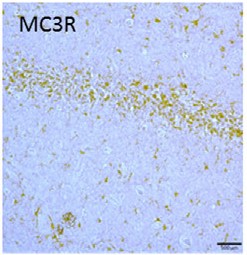Overview
|
Anti-MC3 Receptor (extracellular) Antibody (#AMR-023) is a highly specific antibody directed against an epitope of the rat melanocortin receptor 3. The antibody can be used in western blot, immunohistochemistry, and flow cytometry applications. It has been designed to recognize MC3R from human, mouse, and rat samples.
Application key:
Species reactivity key:

Expression of MC3R in rat hippocampus.Immunohistochemical staining of rat brain sections using Anti-MC3 Receptor (extracellular) Antibody (#AMR-023). MC3R staining (brown) is detected in CA1 region.Adapted from Massey, A.T. et al. (2016) Front. Neurol. 7, 65. with permission of Frontiers.
Applications
 Western blot analysis of mouse (lanes 1 and 3) and rat (lanes 2 and 4) brain lysates:1,2. Anti-MC3 Receptor (extracellular) Antibody (#AMR-023), (1:200).
Western blot analysis of mouse (lanes 1 and 3) and rat (lanes 2 and 4) brain lysates:1,2. Anti-MC3 Receptor (extracellular) Antibody (#AMR-023), (1:200).
3,4. Anti-MC3 Receptor (extracellular) Antibody, preincubated with MC3 Receptor (extracellular) Blocking Peptide (#BLP-MR023).
 Expression of MC3R in rat brainImmunohistochemical staining of perfusion-fixed frozen rat brain sections using Anti-MC3 Receptor (extracellular) Antibody (#AMR-023), (1:100). Expression (green) appears in the hypothalamic periventricular region (horizontal arrow), in some nerve cells (vertical arrow), and in the neuropil (asterisk). Hoechst 33342 is used as the counterstain (blue).
Expression of MC3R in rat brainImmunohistochemical staining of perfusion-fixed frozen rat brain sections using Anti-MC3 Receptor (extracellular) Antibody (#AMR-023), (1:100). Expression (green) appears in the hypothalamic periventricular region (horizontal arrow), in some nerve cells (vertical arrow), and in the neuropil (asterisk). Hoechst 33342 is used as the counterstain (blue).
 Cell surface detection of MC3R by indirect flow cytometry in live intact human THP-1 monocytic leukemia cells:___ Cells.
Cell surface detection of MC3R by indirect flow cytometry in live intact human THP-1 monocytic leukemia cells:___ Cells.
___ Cells + goat-anti-rabbit-FITC.
___ Cells + Anti-MC3 Receptor (extracellular) Antibody (#AMR-023), (2.5μg) + goat-anti-rabbit-FITC.- The control antigen is not suitable for this application.
Citations (1)
- Rat brain sections.
Massey, A.T. et al. (2016) Front. Neurol. 7, 65.
Specifications
- Peptide (C)NSDSLTLEDQFIQHMD, corresponding to amino acid residues 102-117 of rat MC3R (Accession P32244). 1st extracellular loop.

Scientific Background
Melanocortin receptor 3 (MC3R) is one of five members of the melanocortin receptor family, which belongs to the 7-transmembrane domain, G protein-coupled receptor (GPCR) superfamily.
The ligands of these receptors, the melanocortins, are a group of structurally-related peptides comprising the α-, β-, and γ-melanocyte-stimulating hormone (α-, β-, γ-MSH) and the adrenocorticotropic hormone (ACTH), all of which are derived from post-translational processing of a common precursor peptide, proopiomelanocortin (POMC).1,2,3
One of the salient features of the melanocortin signaling system is the presence of two endogenous antagonists, proteins that bind specifically to the receptor and have an inhibitory effect. These antagonist proteins are termed agouti (or agouti signaling protein, ASP) and agouti-related protein (AGRP).1
All five melanocortin receptors bind their agonists (the melanocortins) and their endogenous antagonists (agouti and AGRP) with differing affinities. MC3R is the only one of the melanocortin receptors that shows no difference in binding specificity for any of the melanocortins, binding all of them with equal efficiency. AGRP is the high affinity endogenous antagonist of MC3R.1,2,3
The physiological function of MC3R is still poorly understood. The distribution of MC3R in hypothalamic nuclei of the central nervous system (CNS) suggests a role in the regulation of energy homeostasis. Indeed, studies with MC3R knockout (MC3R KO) mice showed that these mice have increased body fat due to increased feed efficiency.4 In humans, several polymorphisms of the MC3R gene are associated with high insulin levels and obesity in children.5 In addition, expression of MC3R in macrophages is thought to mediate the well known anti-inflammatory effects of α-MSH.6
- Abdel-Malek, Z.A. (2001) Cell. Mol. Life Sci. 58, 434.
- Gantz, I. and Fong, T.M. (2003) Am. J. Physiol. Endocrinol. Metab. 284, E468.
- Wikberg, J.E.S. et al. (2000) Pharm. Res. 42, 393.
- Butler, A.A. et al. (2000) Endocrinology 141, 3518.
- Feng, N. et al. (2005) Diabetes 54, 2663.
- Catania, A. et al. (2004) Pharmacol. Rev. 56, 1.
